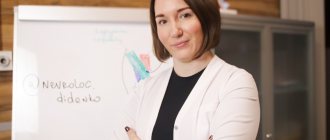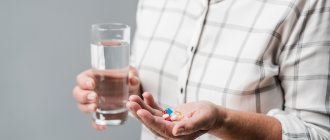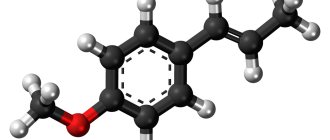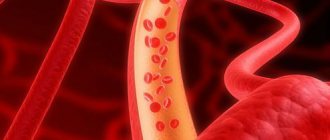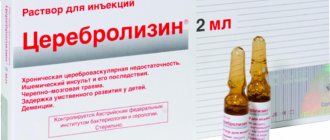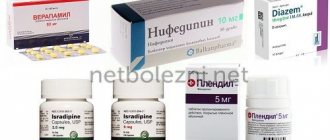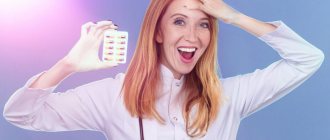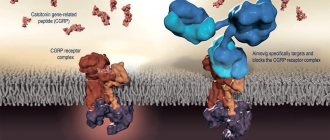A binge is a period of continuous drunkenness that lasts more than one day. It is rightfully considered one of the most severe manifestations of alcoholism. Often it is binge drinking that causes the destruction of a family and a host of complications, including the death of a person.
As a rule, the drinker cannot get out of this state on his own. Pharmacological remedies for binge drinking, sold in pharmacy chains, come to the aid of the patient. What medications are there to help you get rid of binge drinking, can you buy them without a prescription, how to take them - we’ll talk about this in this article.
Detoxification products
The main purpose of detoxification pharmaceuticals is to bind and remove alcohol residues, its breakdown products and other toxic particles. Detoxification does not cure alcoholism, it only helps the body quickly cope with poisoning,
The following groups of detoxification drugs are most often used to overcome binge drinking:
- Absorbents designed to collect and retain toxins on their surface or in their pores. The most striking representative is activated carbon. This is a cheap, natural, safe and quite effective first aid remedy for alcohol poisoning. It is taken at the rate of 1 capsule or tablet per 10-12 kg of weight. The maximum single dose is 15 tablets. Enterosgel, Smecta, Polysorb can be used as absorbents. They are available in tablet or powder form and are taken orally.
- Infusion detoxification solutions. Prescribed to increase blood volume and accelerate the removal of toxins from excess fluid through the kidneys. In this case, crystalloid (based on sodium chloride), colloid solutions - polyglucin, reopliglucin, hemodez, gekodez, and other plasma substitutes can be used. Administered intravenously.
- Laxatives and emetics. The greatest effect is provided by fast-acting medications - castor oil or 25% magnesium sulfate solution.
You need to understand that taking laxatives and absorbents is justified only in cases of minor poisoning or short-term binge drinking, in which there is no significant deterioration in well-being. In all other situations, infusion therapy is required.
Medications for withdrawal symptoms
This group is aimed primarily against hangover and withdrawal symptoms.
This includes:
- Vitamin complexes. Long-term consumption of alcohol-containing drinks destroys vitamins and accelerates their removal from the body. This creates a shortage of vital ingredients. Vitamin C improves immunity and tones the body, B vitamins accelerate blood flow and improve brain function, nicotine restores blood flow through the vessels, promotes detoxification, metabolism and liver function.
- Antihypoxants and metabolites - accelerate interstitial processes, saturate cells with oxygen, which leads to rapid oxidation of toxic substances. Often mildronate, fezam. Succinic and citric acids effectively fight hangovers. They activate tissue metabolism and the functions of organs and tissues, increase efficiency, mental ability, and reduce the toxic effects of alcohol molecules.
- Sedatives and sleeping pills. They allow you to improve the functioning of the nervous system and provide protection to its cells during withdrawal and recovery from it.
Combination medications have proven themselves to be effective:
- Cytoflavin – contains succinic acid, riboflavin (vitamin B2), nicotinamide (vit. PP), riboxin (metabolite). Cytoflavin enhances aerobic glycolysis and the synthesis of γ-aminobutyric acid in neurons, increases the resistance of glial and nerve cells to ischemia, accelerates blood flow and metabolic processes in the central nervous system. Its administration contributes to the regression of neurological symptoms, the elimination of disturbances of consciousness, and the return of cognitive functions of the brain.
- Reamberin – contains meglumine (N-methylglucamine), succinic acid, sodium, potassium, magnesium ions. Reamberin not only accelerates aerobic processes in cells, restoring their energy potential, but also has a moderate diuretic effect. It is administered intravenously (slowly!) at a rate of 6-10 ml/kg.
What drugs are psychoactive
Psychoactive substances (surfactants) differ in the method of production and in their effect on the psyche and body. The production method differs:
- substances of natural origin isolated from plant materials;
- semi-synthetic, that is, synthesized from plants;
- synthetic - produced from other chemicals.
Based on their effect on the psyche, surfactants are divided into the following types of drugs:
Depressants suppress nervous excitement and the activity of the central nervous and respiratory systems. CU depressants include sleeping pills, sedatives, antipsychotics, and tranquilizers. Neuroleptics, or antipsychotics, are substances that suppress nervous activity and reduce excitability. These drugs eliminate delusions and hallucinations. Without affecting consciousness, they suppress emotionality and psychomotor agitation.
Psychostimulants have the opposite effect of depressants. This group of drugs activates the mental activity of the body. To a lesser extent, psychostimulants affect the physical body.
Antidepressants are also psychoactive substances. By influencing the level of neurotransmitters such as dopamine, norepinephrine and serotonin, antidepressants improve mood, relieve anxiety, stimulate mental activity, normalize sleep and appetite. However, they must be taken strictly in the dosages prescribed by the doctor.
Adjuvant therapy
When recovering from a drunken state, great attention is paid to stabilizing the functioning of internal organs.
In this case, the following may be prescribed:
- Pharmaceuticals containing sodium, potassium, calcium, magnesium - these minerals are necessary for the functioning of internal organs, and with prolonged alcoholism, their deficiency occurs. A prominent representative of this group’s means of breaking up binge drinking is Methusol. Administered intravenously, it has a rehydrating, diuretic, detoxifying, and antioxidant effect. With its help, rapid replenishment of circulating blood volume during hypovolemia is achieved, blood viscosity is reduced, its rheological properties are improved, and tissue dehydration is prevented. Exhibits a hemodynamic effect, promotes cell adaptation to lack of oxygen.
- Hepatoprotectors necessary for the protection and restoration of liver cells. This can be Heptral, Essentially, administered intravenously. An excellent effect is provided by Remaxol®, containing succinic acid, meglumine, riboxin, methionine, nicotinamide, sodium, potassium, magnesium chlorides, sodium hydroxide. It reduces bilirubin, improves the release of direct bilirubin into bile and the oxidation of cholesterol.
- Nootropics – improve brain function. The most commonly administered drug is Piracetam.
Over-the-counter tablets
Medicines aimed at combating alcoholism should be prescribed by a narcologist. However, there are also those that can be used in a variety of cases without serious danger. Among them:
- Glycine. It has an antidepressant effect. It is used to improve a person’s psychological state in combination with many other methods of therapy.
- Medichronal. These tablets have a detoxifying effect, stimulate metabolic processes, increase the activity of the cerebral cortex, which can improve the psycho-emotional background, relieve stress and improve sleep. In addition, Medichronal has a positive effect on liver function.
- Proprothene-100. Classified as a homeopathic medicine, it also has antidepressant properties. Allows you to achieve the required concentrations of biologically active substances in the human brain, helps reduce cravings for alcohol.
What are psychotropic substances
Psychotropic substances are a group of various chemical compounds that cause a change in mental state through an effect on the nervous system. Psychoactive substances (PAS) is a similar term that reflects the same thing, but in practice it is more often used to describe that group of drugs and substances that can cause addiction, dependence, drug addiction and substance abuse.
What are potent substances
Separately, it is necessary to say about the group of potent substances. This is a group of chemicals that have a strong and dangerous effect on the body, and therefore are especially controlled by the authorities. The list of potent substances (like the list of toxic substances) is determined by state laws and changes periodically (some substances are added to it, some are removed). See the current list HERE. These lists differ in different states. A small part of psychotropic substances is included in the list of potent substances, while the other part is not. That is, potent and psychotropic substances are different, but partially including each other groups.
What are narcotic substances
This is part of the psychoactive (psychotropic) substances (both potent and not included in the group of potent ones), which, due to their ability to cause addiction and dependence, are included in a special list (list) by the state. This list is constantly changing and differs in each state. Narcotic substances are drugs. The distribution of narcotic substances is illegal, and the state is fighting it.
Since ancient times, the ability of some drugs used to change the mental state has been noticed. One of the most ancient psychotropic substances, which is still widespread today, is alcohol (ethyl alcohol). Alcohol taken in small quantities causes inhibition of the cerebral cortex, leading to euphoria. As the dose of alcohol increases, inhibition increases and complete depression of the psyche occurs - a state of anesthesia develops (complete lack of consciousness, lack of pain sensitivity).
A significant part of the known psychotropic substances is used for medical purposes: for the treatment of many diseases (mainly mental disorders and behavioral disorders). In addition, they are used in scientific research. A small part of psychotropic drugs, being drugs, are produced and distributed illegally. While such a social and medical phenomenon as drug addiction exists, despite the measures taken, unfortunately, it is not possible to stop this illegal trafficking.
Herbs and fees
It should be noted that there are a fairly large number of folk remedies that can be used for heavy drinking. Some of the herbal medicines in the form of special filter bags are sold in modern pharmacies. These include:
- Stopped. The composition includes a large number of herbs: tansy, centaury, thyme, wormwood and others. They can improve digestion, choleretic processes, psycho-emotional background, and also significantly reduce the craving for drinking alcohol.
- Aralia tincture. Helps restore adrenal function and strengthen the nervous system.
All of them are sold without a prescription.
Need some advice?
OR CALL A DOCTOR
CALL!
+7
Types of psychotropic drugs
Doctors distinguish several main groups:
- Anxiolytics (minor tranquilizers). One of the most common groups, used to reduce anxiety, relieve pathological fear and panic, and restore sleep. Some tranquilizers have anticonvulsant and stabilizing effects on the autonomic nervous system. Read more about these drugs HERE.
- Antidepressants (thymoanaleptics). They are used to treat borderline conditions, pain syndromes, psychosomatic diseases, depression and anxiety disorders. Read more about them HERE.
- Neuroleptics (antipsychotics). They have the ability to remove symptoms of psychosis, such as delusions, hallucinations, aggression, manic states, etc. Read more about antipsychotics HERE.
- Psychostimulants. These include caffeine, nicotine, phenamine.
- Psychodysleptics (hallucinogens). Examples: lysergic acid diethylamide, psilocybin and others.
The first three groups are widely used in medicine, being the basis of psychopharmacotherapy. In addition, mood stabilizers, nootropics, and ethyl alcohol used for the treatment of mental disorders are divided into separate groups.
According to the primary mechanism of action on the nervous system, three groups of psychotropic substances are distinguished: stimulant, inhibitory and mixed action.
According to the method of preparation, there is a division into three groups: plant origin, synthetic and semi-synthetic products.
List of psychotropic drugs
The list of these funds is constantly updated and changed. For a detailed and current list of all psychotropic drugs subject to control in the Russian Federation, see HERE.
Trafficking in psychotropic drugs
The distribution of psychotropic drugs is strictly regulated by laws and orders. The production, distribution, acquisition and use are limited in order to exclude the use of these substances for the purpose of poisoning, intoxication and unauthorized experiments. There are special laws and orders that stipulate all this, and in addition, there is punishment (even criminal) for violating these rules.
Use of psychotropic drugs
Any use of psychotropic and narcotic substances without a doctor’s prescription is considered illegal. If prescribed by a doctor, taking such medications is permitted. If the doctor determines an indication for taking medications belonging to the group of psychotropic drugs, then he makes an appropriate entry in the medical record. After this, the patient begins to receive the medicine as prescribed by the doctor. If the therapy must be carried out at home, the doctor writes a special prescription, according to which the drug can be purchased at the pharmacy.
How to understand that a person is using psychotropic substances
There are several ways to determine whether a psychotropic substance has been used:
- Clinical: examination by a doctor. The use of a psychotropic drug causes certain symptoms that can be determined by a doctor. The most common symptoms: changes in mental state (euphoria, lethargy, aggressiveness), neurological changes (nystagmus, coordination disorders, altered reflexes, convulsions), somatic signs (changes in body temperature, pulse, blood pressure, heart rate).
- Chemical detection of a substance in blood, urine or saliva. Such analyzes are carried out in specialized laboratories.
- Determination of antibodies in the blood by ELISA (enzyme-linked immunosorbent assay) to certain substances. This relatively new method makes it possible to detect use even several months after the last use of a psychotropic substance. See similar research HERE.
Remember, self-administration of psychotropic substances is dangerous to health and illegal. For all questions related to mental health and addiction to psychotropic (psychoactive) substances, please contact us. We will try to help you.
